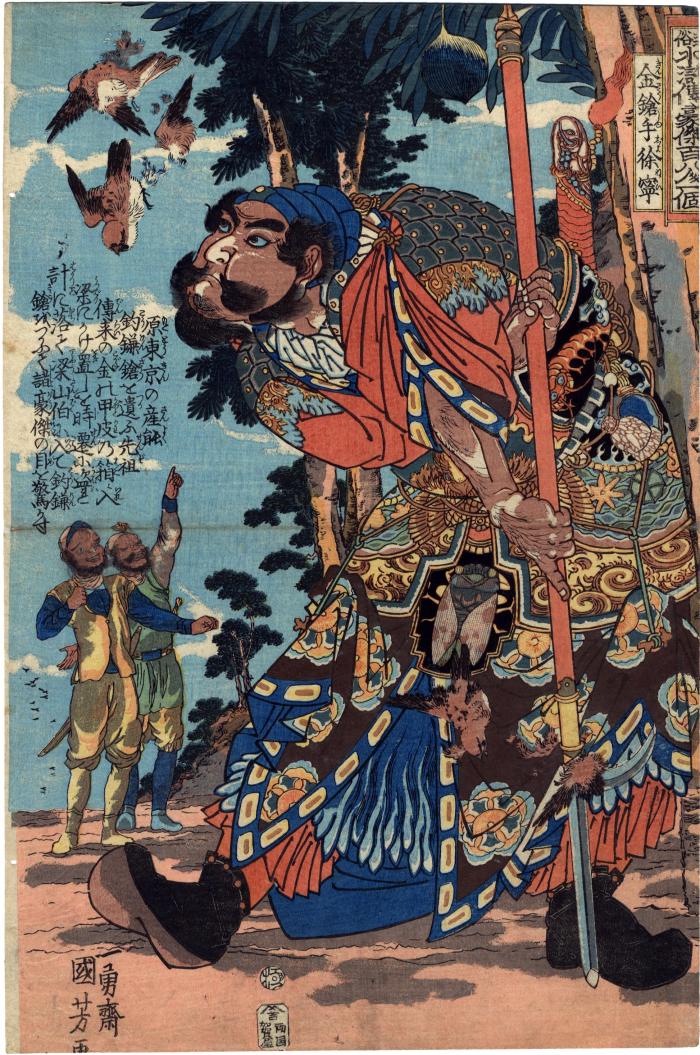Utagawa Kuniyoshi (歌川国芳) (artist 11/15/1797 – 03/05/1861)
Kinsōshu Jonei (Xu Ning 徐寧 - the Metal Lancer) cutting down sparrows with his hooked spear from the series The Hundred and Eight Heroes of the Popular Suikoden (Tsūzoku Suikoden gōketsu hyakuhachinin no hitori - 通俗水滸伝豪傑百八人之一個)
ca 1827 – 1830
9.75 in x 14.5 in (Overall dimensions) Japanese woodblcok print
Signed: Ichiyūsai Kuniyoshi ga
一勇斎国芳画
Publisher: Kagaya Kichiemon
(Marks 195 - seal 22-027)
Censor's seal: kiwame
British Museum
Tokyo National Museum
Nationaal Museum van Wereldculturen (Rijksmuseum Volkenkunde, Leiden) via Ritsumeikan University Inge Klompmakers wrote of this print in Of Brigands and Bravery: Kuniyoshi's Heroes of the Suikoden: "In chapter 53 the emperor orders military lord Sōben Koenshaku to overthrow the Ryōsanpaku gang once and for all. Victorious on a number of occasions, the general and his men are a powerful force to be reckoned with. Ryōsanpaku hero Kinsenhyōshi Tōryū... believes, however, that with the assistance of his cousin Kinsōshu Jonei and his favourite weapon, the hook-bladed spear, the imperial forces could be overtaken. He therefore wants to become a member of the gang. Jonei works in the imperial foundry and is very adept in the use of the hook-bladed spear. In chapter 55 he is cleverly lured to Ryōsanpaku when his precious suite of armour is stolen by Kojōsō Jisen... and in his search to find it, Jonei - accompanied by Tōryu who feigns having seen it at Ryōsanpaku - is led to the robbers' hide-out. Jonei decides then to stay at Ryōsanpaku with his cousin. He successfully instructs the Ryōsanpaku rebels in how to wield the hook-bladed spear. After much practice, the heroes inflict such heavy losses upon Koenshaku and his forces that the general flees. Koenshaku is eventually captured by the bandits in chapter 57 and because he does not dare face the authorities again he joins up with his captors."
****
"In Kuniyoshi's portrait of Jonei, the hero has just given a show of his favorite weapon, although in this case he holds a smooth lance rather than a hook-bladed spear. In the background two men in western-style clothing watch with admiration as the Ryōsanpaku rebel cuts off the wings of two sparrows. The influence of Western art is likewise seen in the cloud formation and in the play of light and dark which is best seen in the depiction of the two spectators, the trunk of the tree and the umbrellas on the ground. Noteworthy also is the nusual pulisher's seal of Kagaya Kichibei. The name Kagaya is written in kanji ('Chinese characters') rather than in hiragana (cursive Japanese syllabary) as is customary in most examples in this series."
Quoted from: Of Brigands and Bravery: Kuniyoshi's Heroes of the Suikoden by Inge Klompmakers, p. 114 with a full-color image on p. 115.
Jonei is a cousin to Kinsenhyōshi Tōryū. (See #s 449 and 1047 in the Lyon Collection.)
****
Xu Ning is first mentioned at the beginning of chapter 56 of the Outlaws of the Marsh. This is on page 899 of volume II.
"My ancestors have always been armorers," Tang Lang said to the chieftains. "Because of this skill my father was raised by Border Area Governor Old General Zhong to be head of the Yanan garrison. The linked cavalry method won victories for the previous emperor. The only way you can beat it is with barbed lances. I have a drawing of such a lance, passed down to me by my family, which can serve as a likeness. I can make one for you, but I don't know how to use it. Only my cousin, an arms instructor knows. The art has been handed down from generation to generation. They never teach it to any outsider. My cousin can ply the lance ahorse or on foot. When he goes into action, he's like nothing human.****
"You don't mean Xu Ning, Arms Instructor of the Metal Lancers?" Lin Chong interrupted.
"That very man." "
If you look closely at his outfit you will see a centipede decorating an area toward his back above his waistline and a large cicada, as if seen from above, in the center below. Another falling, slain sparrow is in front of the lower half of his clothing. Two small pieces of brown coral have been attached to his outfit by some kind of cordage.
****
Illustrated:
1) in color in Japanese Prints: Images of the Floating World, Barry Davies Oriental Art, #70, illustrated on p. 95.
2) in full-page color reproduction (n.p.) in Ukiyoe ni egakareta Chūgoku ten (浮世絵 に 描かれた 中国 展), Ukiyoe Ōta Bijutsukan, 1982, cat. #69.
3) in full-page color reproduction in Of Brigands and Bravery: Kuniyoshi's Heroes of the Suikoden by Inge Klompmakers, Hotei Publishing, 1998, #33, page 115.
****
The text reads: 原東京の産 能鎌鎗を遣ふ 先祖伝来の金の甲皮の箱ニ入梁にかけ置しを時遷に盗れ計に落て梁山泊に入て釣鎌鎗をつかふて諸豪傑の目を驚かす
Kagaya Kichiemon (加賀屋吉右衛門) (publisher)
Suikoden (水滸傳) (genre)
